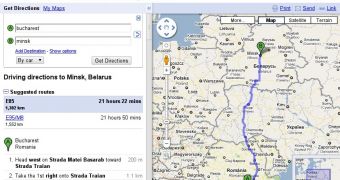Google Maps is a great tool by itself, having access to quite accurate maps of most of the world, satellite imagery, terrain, and so on, which is pretty nice. But one of the most useful features consists of driving directions, enabling people to use Google Maps as a navigational utility, to plan trips and get around foreign cities. In fact, with the Google Maps Navigation tool, any smartphone can become a full-blown GPS navigation device.
But driving directions data can be expensive to acquire. Thanks to the Google Map Maker program, though, a bunch of more countries and territories, 111 in total, now get the driving directions feature as well.
“Members of our Google Map Maker community have always told us that the biggest milestone after launching maps for their countries is adding driving directions. A few months ago we launched driving directions in 18 countries in Eastern Europe and Asia-Pacific,” Vishwajith Krishnamurthy, software engineer, Zareer K'Maneck, program manager, and Manik Gupta, product manager at Google, wrote.
“We have now enabled directions in 111 new countries and territories across the globe. So, whether you find yourself in Lima, Peru or visiting Iceland or driving from Johannesburg to Nairobi, you can now use Google Maps to find out how to get around,” they announced.
The full list of new countries is available in the post on the Google blog. Most of the countries are in less developed regions of the world, Africa, South America and so on, where Internet access is more of a privilege than the basic right it has come to be considered in Europe or the US.
But it’s precisely those regions that benefit the most from the feature. No commercial outfit would bother creating mapping data complete with driving directions for countries where it wouldn’t make much economical sense, and that, unfortunately, means much of the world. Now, Google isn’t taking too much money out of its very, very deep pockets to do this, but the simple fact that it’s making the tools necessary to create and add, and then access the data is more than most large companies out there would do.

 14 DAY TRIAL //
14 DAY TRIAL //